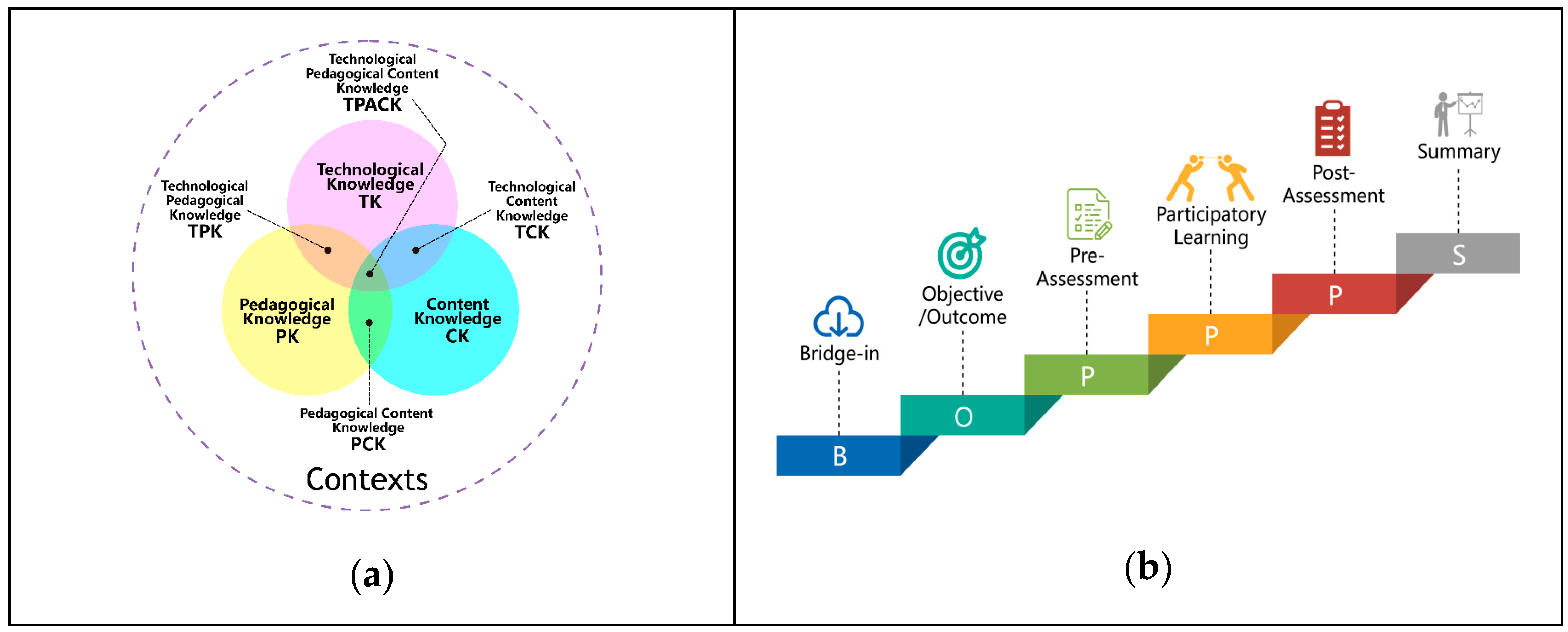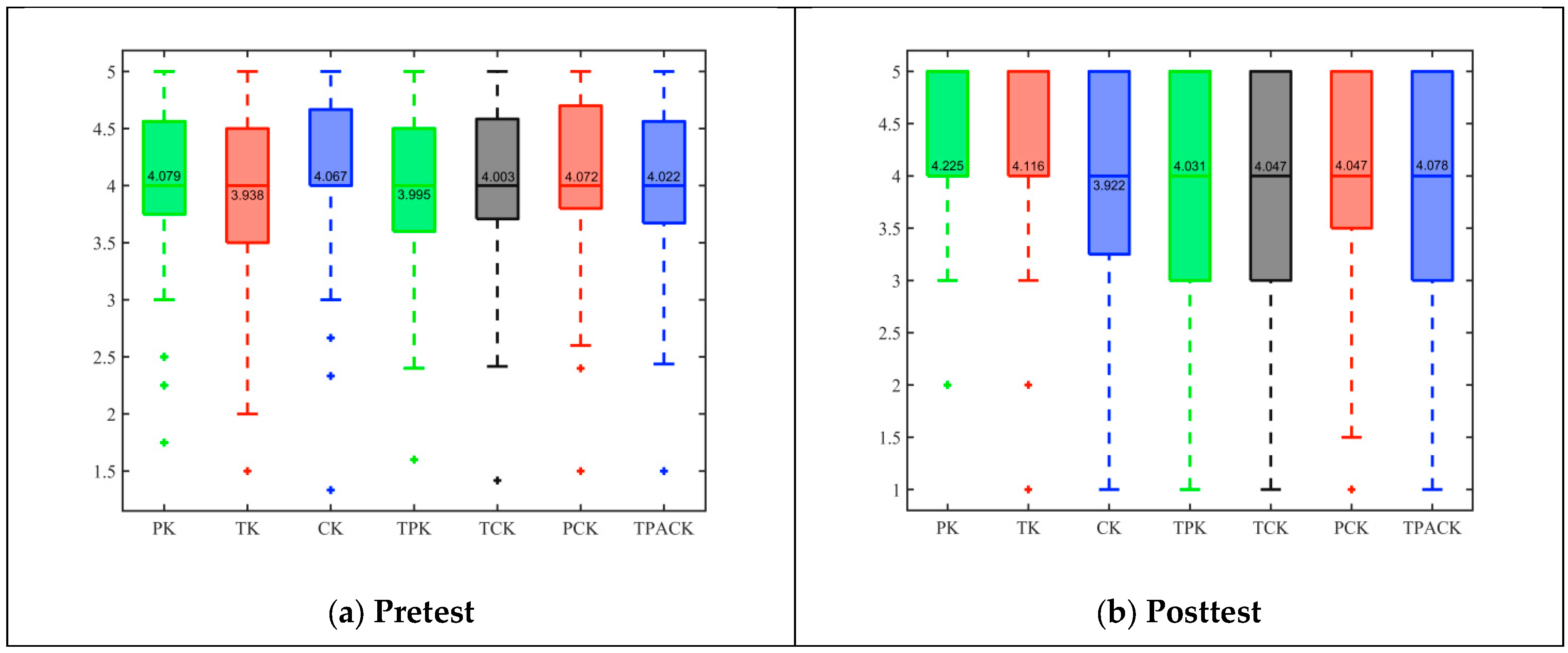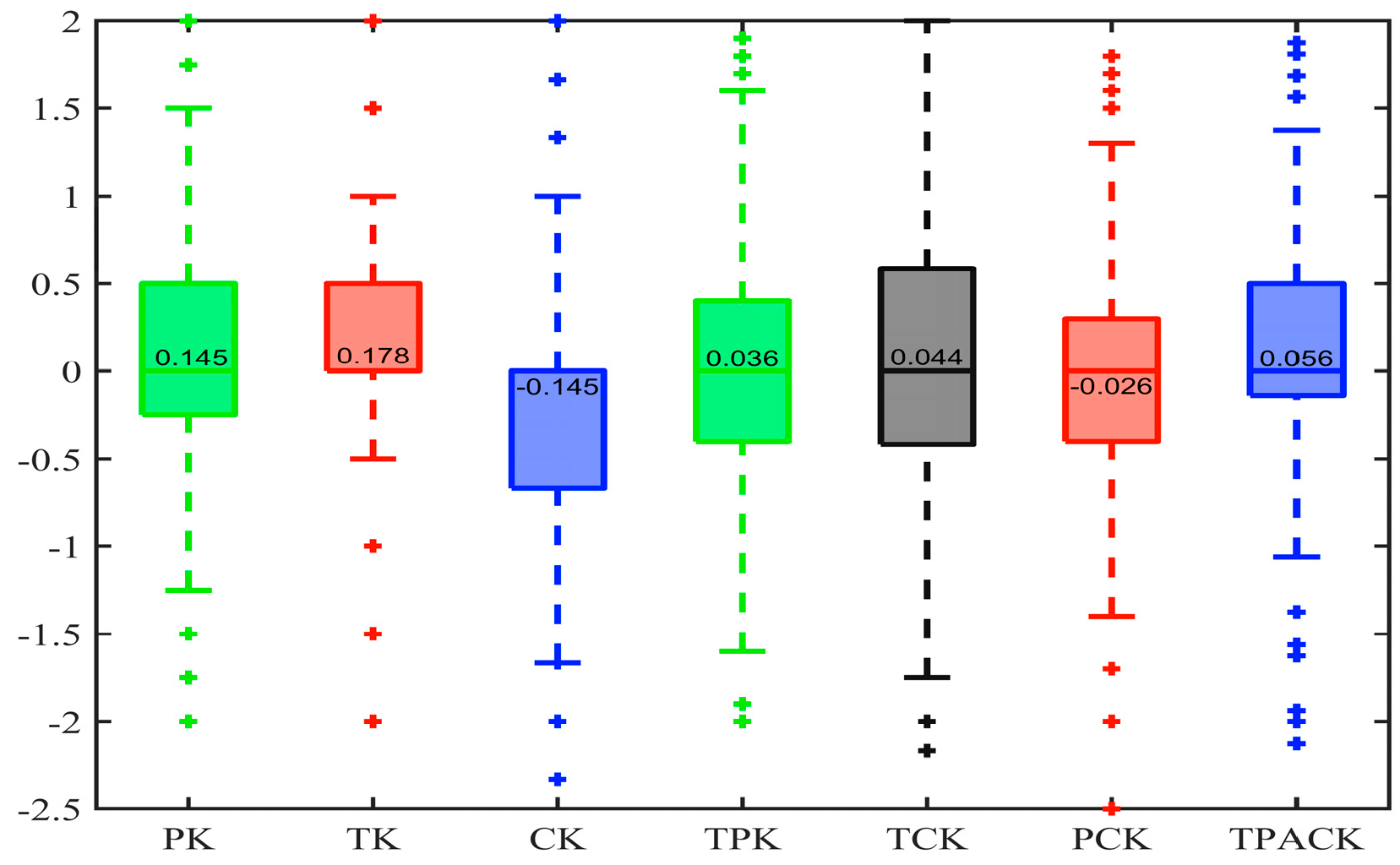The Construction and Practice of a TPACK Development Training Model for Novice University Teachers
Abstract
:1. Introduction
2. Design Principles
- Smart-tool-based design: smart teaching tools have opened up an infinite world of possibilities for informatized teaching. This training model offers learning projects on smart teaching tools and encourages teachers to choose the information technology suited to their pedagogical objectives, create a participatory learning environment, and avoid mindless and inefficient technology use. This forms the foundation of TPACK-based capacity building for novice teachers [17].
- Pedagogy-driven design: as this model is driven by a BOPPPS-based structured pedagogy, it offers novice teachers with a weaker foundation in pre-service professional development a system and methodology to guide their teaching practices. Hence, it facilitates learning practices related to technological pedagogical knowledge (TPK) and effectively boosts novice teachers’ learning and practical efficiency.
- Microteaching-integrated design: the development of TPACK cannot be truly promoted without constant attempts to effectively integrate content knowledge (CK), technological knowledge (TK), and pedagogical knowledge (PK) and to optimize teaching effectiveness through microteaching. This model provides a setting for the deliberate practice of TPACK and creates more possibilities for reflecting on and optimizing teaching practices, based on real-time feedback from the student’s perspective. It helps novice teachers to readily step up to the podium, establish a firm footing, and interact with students off the podium to achieve student-centered participatory teaching.
- Creatively enhanced design: Through two to three rounds of microteaching exercises, educators can repeatedly attempt to integrate TK, PK, and CK creatively and continue to incorporate opinions and advice from the learners’ perspective, creating endless possibilities for optimizing smart teaching.
3. Construction of the BOPPPS–TPACK Training Model
- Bridge-In: the key to the bridge-in stage is to inspire novice teachers’ interest and motivation to learn, and to answer the “why” of learning. This can include arranging for teachers to “vote with their feet” on whether or not good teaching is about good design, brainstorming answers to questions like how to design online–offline hybrid teaching, introducing topics on effective teaching with the support of information technology, and discussing the importance of TPACK. Information technology solutions, such as Rain Classroom’s bullet screen feature and the Zhitiao Fun teaching tool, can also be used to collect learners’ views in real-time.
- Objective/Outcome: the learning objectives consist of three dimensions: knowledge learning, skills training, and emotional development. They include familiarizing oneself with every element of BOPPPS and being able to operate two to three types of information technology tools; being able to design BOPPPS–TPACK microteaching sessions independently; completing two rounds of TPACK microteaching exercises and identifying each TPACK element and its level of integration in the exercises; and adapting to the demands for informatized teaching and actively enhancing one’s TPACK capabilities to achieve effective student-centered teaching. Trainers should clearly outline the training objectives to ensure they are assessable and measurable.
- Pre-Assessment: the pre-assessment concerns trainee teachers’ prior knowledge reserves. Showcasing BOPPPS–TPACK demonstration lessons and arranging for teachers to identify the PK and TK involved can help them to adjust the level of difficulty and progress of instruction in a timely manner. Utilizing informatized teaching platforms to promptly collect pre-assessment data is both a training requirement and a demonstration of one’s informatized teaching skills.
- Participatory Learning: the participatory learning stage is central to the model, and focuses on enhancing teachers’ TPK and technological content knowledge (TCK) by having them complete Microteaching Design 2 and the TPACK Microteaching Exercises. Designing microteaching exercises based on adults’ learning characteristics from a constructivist perspective enables trainers to make timely adjustments to the assisted learning strategies while helping learners to review their learning progress and ensure that the training objectives are achieved through the learning–practice–feedback–optimization–practice loop. Learner-centered participatory learning activities are not limited to a fixed component, but are perpetuated throughout various components of the training model.
- Post-Assessment: learning effectiveness can be examined promptly through TPACK Microteaching Exercise 2, the microteaching lesson plan, and microteaching video data, among others. Trainee teachers can also reinforce their learning by observing one another and transferring their observations to classroom practices, to truly uphold and apply the philosophy of student-centered participatory teaching.
- Summary: this is when trainers and trainee teachers come together to systematically organize, reflect on, and summarize their learned content, and discuss whether the TPACK objectives have been achieved. They also reflect on the pain points and key points in the CK–PK–TK integrated design, and personalize extended plans for teachers’ subsequent professional development. Meanwhile, feedback from the trainee teachers is conducive to refining the model.
4. Empirical Research into the BOPPPS–TPACK Training Model
4.1. Research Methods
4.1.1. Quantitative Research Method
4.1.2. Qualitative Research Method
4.2. Research Process
5. Results and Discussion
5.1. Novice Trainee Teachers’ Self-Reported TPACK
5.2. Interviews and Electronic Record Analysis on TPACK Learning Effectiveness
6. Conclusions
Author Contributions
Funding
Institutional Review Board Statement
Informed Consent Statement
Data Availability Statement
Conflicts of Interest
References
- Feng, X.Y.; Guo, W.R.; Huang, L.Y. Teachers’ professional development in the smart age: Challenges and pathways. Distance Educ. China 2021, 11, 1–8+76. [Google Scholar]
- Wu, H.Q. Research on teachers’ TPACK promotion path based on collaborative knowledge construction: A design-based research. E-Educ. Res. 2017, 10, 118–123. [Google Scholar]
- Mishra, P.; Koehler, M.J. Technological pedagogical content knowledge: A framework for teacher knowledge. Teach. Coll. Rec. 2006, 108, 1017–1054. [Google Scholar] [CrossRef]
- Koehler, M.J.; Mishra, P.; Cain, W. What is technological pedagogical content knowledge (TPACK)? J. Educ. 2013, 193, 13–19. [Google Scholar] [CrossRef] [Green Version]
- Wang, Q.A. Review about TPACK research in China from 2009 to 2018. J. Inn. Mong. Norm. Univ. (Educ. Sci.) 2019, 7, 67–74. [Google Scholar]
- Yan, Z.M.; Fu, J.L.; Zhu, Y.L.; Duan, Y. AI-technological pedagogical content knowledge (AI-TPACK), connotation, teaching and learning practice and future issues. Distance Educ. 2020, 38, 23–34. [Google Scholar]
- Yan, H.B.; Shan, J.H. From training to empowerment: Constructing a blueprint for teacher professional development in the post-epidemic period. E-Educ. Res. 2020, 6, 13–19. [Google Scholar]
- Xie, Y.H.; Wan, J.; Xia, X. Influence of university teachers’ TPACK level on online teaching effects. J. Cent. China Norm. Univ. Nat. Sci. 2022, 2, 304–310. [Google Scholar]
- Wang, J.X.; Wang, S.Q.; Chen, W.G. Towards a blended teaching competency model for university faculty based on TPACK. Chin. J. Distance Educ. 2022, 8, 26–34. [Google Scholar]
- Guo, S.N.; Wu, Y.H. Teachers in the era of artificial intelligence in vision of social role theory: Distress, attribution, and clarification. E-Educ. Res. 2022, 6, 18–24+60. [Google Scholar]
- Li, J.Y. Ten years of “National Teacher Training Program”: The practice and future development of the professionalization of teacher training in China. Teach. Dev. Res. 2020, 3, 15–26. [Google Scholar]
- Han, X.B.; Ma, J.; Cheng, J.G. Analysis of relationships among group behaviors of teachers and students under different implementation strategies of blended learning in colleges and universities. E-Educ. Res. 2017, 12, 37–43. [Google Scholar]
- Xu, R.C.; Dong, Y.; Lu, L.J. Research on novice teachers’ technological pedagogical content knowledge based on the nine-factor model. Mod. Distance Educ. Res. 2015, 1, 98–105. [Google Scholar]
- Dong, G.W.; Zhao, G.Q.; Guan, Y.J.; Wang, J. On design and practice of the effective teaching mode (BOPPPS) in foundation courses in engineering colleges based on the rain class platform. Res. Higher Educ. Eng. 2020, 5, 176–182. [Google Scholar]
- Zhang, J.X.; Zhu, L. On the effective classroom teaching design based on BOPPPS model. Vocat. Tech. Educ. 2016, 11, 25–28. [Google Scholar]
- Liang, K.H.; Li, J.H. Minimalist training: A new training approach of information technology application ability to enhance teachers’ sense of acquisition. E-Educ. Res. 2021, 4, 122–128. [Google Scholar]
- Duan, Y.M.; Yan, Z.M.; Yu, S.Y. Research on the component mechanism of preservice teachers’ TPACK. Teach. Educ. Res. 2016, 6, 50–58. [Google Scholar]
- Li, J.Z.; Feng, L.Z.; Yuan, Y.F. Analysis and reflections on TPACK research in China. E-Educ. Res. 2015, 11, 102–108. [Google Scholar]
- Koh, J.H.L.; Chai, C.S.; Tsai, C.C. Demographic factors, TPACK constructs, and teachers’ perceptions of constructivist-oriented TPACK. J. Educ. Technol. Soc. 2014, 17, 185–196. [Google Scholar]
- Wang, Y. The mode of pre-job training for university teachers based on the perspective of TPACK. China Educ. Technol. 2014, 3, 117–122. [Google Scholar]
- Chen, X.M. Why is deliberate practice needed in learning to teach. Shanghai Teach. 2021, 4, 79–82. [Google Scholar]
- Li, S.Q. Reflection on local practice of instructional skills workshop. Shanghai Teach. 2021, 4, 53–60. [Google Scholar]
- Wei, Z.H.; Hu, X.T.; Yu, W.H. TPACK development mechanism of university teachers in the context of MOOC teaching. Teach. Educ. Res. 2021, 2, 23–30. [Google Scholar]




| No. | Time Allocated | Task List | Participants and Roles | ||
|---|---|---|---|---|---|
| Instructor | Other Learners (In the Role of Students) | Facilitator | |||
| 1 | 5–10 min | Pre-instruction preparation (e.g., teaching aids, PowerPoint slides, and personal hygiene) | √ | √ | |
| 2 | 10 min | BOPPPS microteaching and participatory learning | √ | √ | √ |
| 3 | 5–7 min | Guidance by the facilitator and written feedback by group members | √ | √ | √ |
| 4 | 13–15 min | Oral feedback by group members and summary by the facilitator | √ | √ | √ |
| Total | 40 min | ||||
| Discipline | TK Learning Checklist Regarding Information Technology | Scenario(s) of Application | |
|---|---|---|---|
| Generic TK Learning | Personalized TK Learning | ||
| Horticulture | Remote live streaming and online teaching management platforms (e.g., UMU, DingTalk, Tencent Meeting, KeTang. Cool, Qing Hua Online, and Xuexitong), PowerPoint design, video editing, image processing, audio processing, pedagogical data analysis, and mind mapping. | Production of Flash animations; online survey systems; Rain Classroom | Demonstration of the irrigation process; collection and analysis of student feedback. |
| Plant Protection | Camtasia screen-recording software; DeepDream | Editing of videos related to plant disease control; image generation. | |
| Biotechnology | Obs Studio screen-recording software; production of Adobe After Effects animations; Rain Classroom. | Micro-lesson production; hybrid teaching; demonstration of biotechnology applications. | |
| Mathematics | Animations in the Geometer’s Sketchpad; matrix computations with MATLAB. | Equation derivation. | |
Disclaimer/Publisher’s Note: The statements, opinions and data contained in all publications are solely those of the individual author(s) and contributor(s) and not of MDPI and/or the editor(s). MDPI and/or the editor(s) disclaim responsibility for any injury to people or property resulting from any ideas, methods, instructions or products referred to in the content. |
© 2023 by the authors. Licensee MDPI, Basel, Switzerland. This article is an open access article distributed under the terms and conditions of the Creative Commons Attribution (CC BY) license (https://creativecommons.org/licenses/by/4.0/).
Share and Cite
Zhang, S.; Zhou, A. The Construction and Practice of a TPACK Development Training Model for Novice University Teachers. Sustainability 2023, 15, 11816. https://doi.org/10.3390/su151511816
Zhang S, Zhou A. The Construction and Practice of a TPACK Development Training Model for Novice University Teachers. Sustainability. 2023; 15(15):11816. https://doi.org/10.3390/su151511816
Chicago/Turabian StyleZhang, Suiling, and Aibao Zhou. 2023. "The Construction and Practice of a TPACK Development Training Model for Novice University Teachers" Sustainability 15, no. 15: 11816. https://doi.org/10.3390/su151511816
APA StyleZhang, S., & Zhou, A. (2023). The Construction and Practice of a TPACK Development Training Model for Novice University Teachers. Sustainability, 15(15), 11816. https://doi.org/10.3390/su151511816




